University Constitutional Law Essay: Senate Representation and Reform
VerifiedAdded on 2023/06/05
|9
|2844
|277
Essay
AI Summary
This essay delves into the historical context and structure of the Australian Senate, focusing on the rationale behind equal state representation as enshrined in the Constitution. It examines the arguments for and against proportional representation, exploring the potential benefits such as improved minority representation and a more accurate reflection of voter preferences. The essay analyzes the current electoral system, highlighting its limitations and discussing how proportional representation could be achieved through mechanisms like the Single Transferable Vote. It references relevant constitutional provisions and legal precedents, ultimately arguing for constitutional reform to enhance the fairness and representativeness of the Senate.
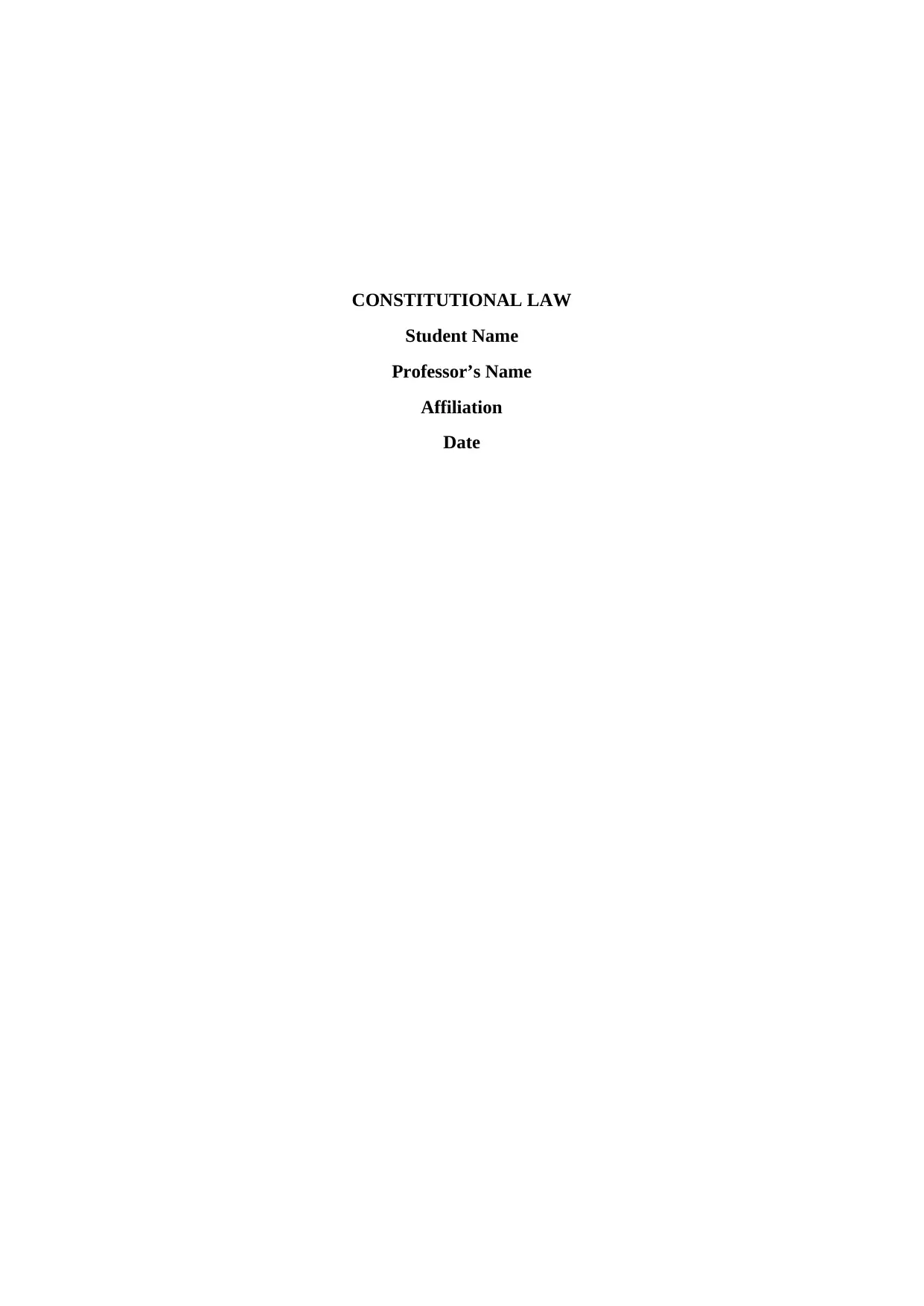
CONSTITUTIONAL LAW
Student Name
Professor’s Name
Affiliation
Date
Student Name
Professor’s Name
Affiliation
Date
Paraphrase This Document
Need a fresh take? Get an instant paraphrase of this document with our AI Paraphraser
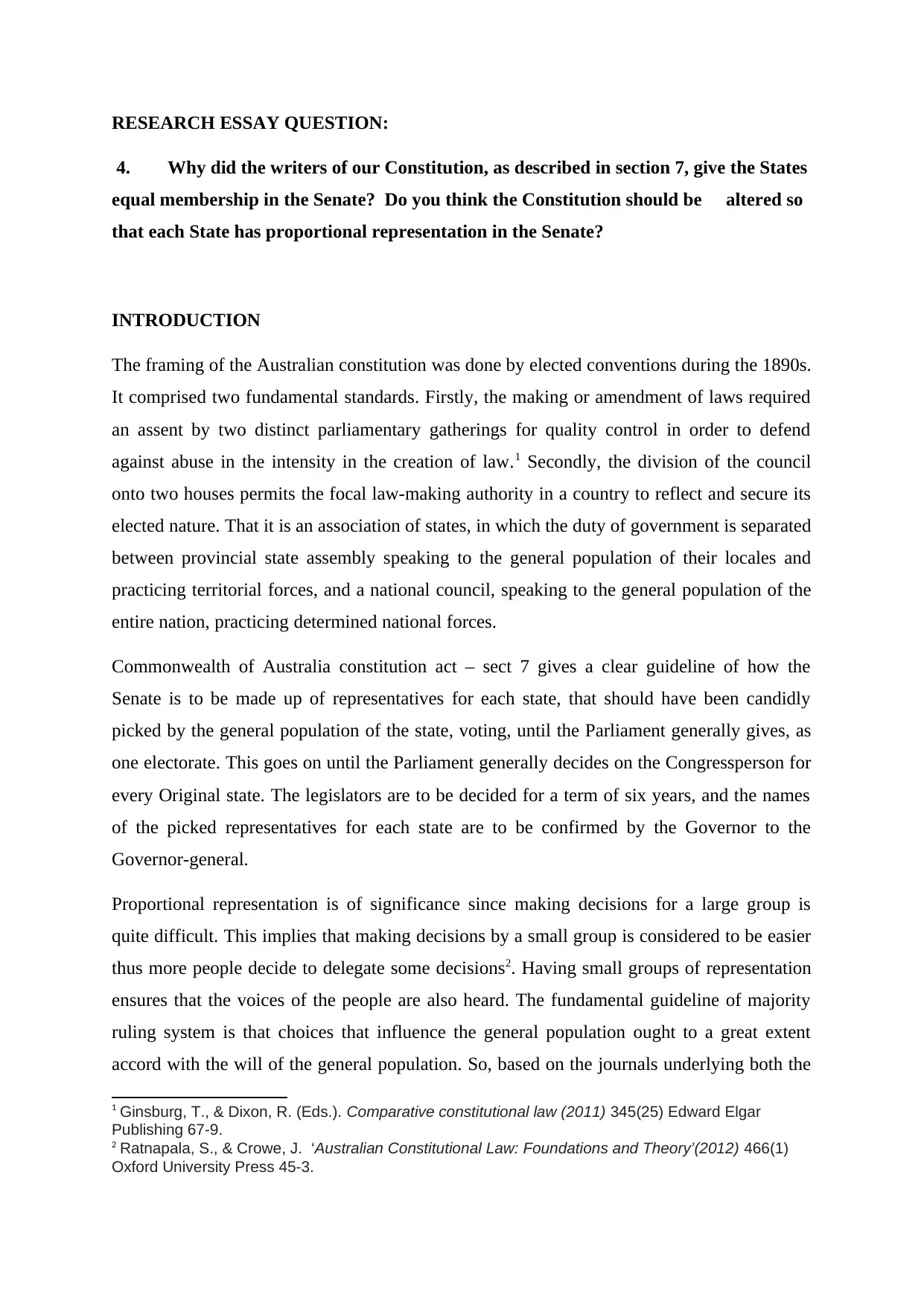
RESEARCH ESSAY QUESTION:
4. Why did the writers of our Constitution, as described in section 7, give the States
equal membership in the Senate? Do you think the Constitution should be altered so
that each State has proportional representation in the Senate?
INTRODUCTION
The framing of the Australian constitution was done by elected conventions during the 1890s.
It comprised two fundamental standards. Firstly, the making or amendment of laws required
an assent by two distinct parliamentary gatherings for quality control in order to defend
against abuse in the intensity in the creation of law.1 Secondly, the division of the council
onto two houses permits the focal law-making authority in a country to reflect and secure its
elected nature. That it is an association of states, in which the duty of government is separated
between provincial state assembly speaking to the general population of their locales and
practicing territorial forces, and a national council, speaking to the general population of the
entire nation, practicing determined national forces.
Commonwealth of Australia constitution act – sect 7 gives a clear guideline of how the
Senate is to be made up of representatives for each state, that should have been candidly
picked by the general population of the state, voting, until the Parliament generally gives, as
one electorate. This goes on until the Parliament generally decides on the Congressperson for
every Original state. The legislators are to be decided for a term of six years, and the names
of the picked representatives for each state are to be confirmed by the Governor to the
Governor-general.
Proportional representation is of significance since making decisions for a large group is
quite difficult. This implies that making decisions by a small group is considered to be easier
thus more people decide to delegate some decisions2. Having small groups of representation
ensures that the voices of the people are also heard. The fundamental guideline of majority
ruling system is that choices that influence the general population ought to a great extent
accord with the will of the general population. So, based on the journals underlying both the
1 Ginsburg, T., & Dixon, R. (Eds.). Comparative constitutional law (2011) 345(25) Edward Elgar
Publishing 67-9.
2 Ratnapala, S., & Crowe, J. ‘Australian Constitutional Law: Foundations and Theory’(2012) 466(1)
Oxford University Press 45-3.
4. Why did the writers of our Constitution, as described in section 7, give the States
equal membership in the Senate? Do you think the Constitution should be altered so
that each State has proportional representation in the Senate?
INTRODUCTION
The framing of the Australian constitution was done by elected conventions during the 1890s.
It comprised two fundamental standards. Firstly, the making or amendment of laws required
an assent by two distinct parliamentary gatherings for quality control in order to defend
against abuse in the intensity in the creation of law.1 Secondly, the division of the council
onto two houses permits the focal law-making authority in a country to reflect and secure its
elected nature. That it is an association of states, in which the duty of government is separated
between provincial state assembly speaking to the general population of their locales and
practicing territorial forces, and a national council, speaking to the general population of the
entire nation, practicing determined national forces.
Commonwealth of Australia constitution act – sect 7 gives a clear guideline of how the
Senate is to be made up of representatives for each state, that should have been candidly
picked by the general population of the state, voting, until the Parliament generally gives, as
one electorate. This goes on until the Parliament generally decides on the Congressperson for
every Original state. The legislators are to be decided for a term of six years, and the names
of the picked representatives for each state are to be confirmed by the Governor to the
Governor-general.
Proportional representation is of significance since making decisions for a large group is
quite difficult. This implies that making decisions by a small group is considered to be easier
thus more people decide to delegate some decisions2. Having small groups of representation
ensures that the voices of the people are also heard. The fundamental guideline of majority
ruling system is that choices that influence the general population ought to a great extent
accord with the will of the general population. So, based on the journals underlying both the
1 Ginsburg, T., & Dixon, R. (Eds.). Comparative constitutional law (2011) 345(25) Edward Elgar
Publishing 67-9.
2 Ratnapala, S., & Crowe, J. ‘Australian Constitutional Law: Foundations and Theory’(2012) 466(1)
Oxford University Press 45-3.
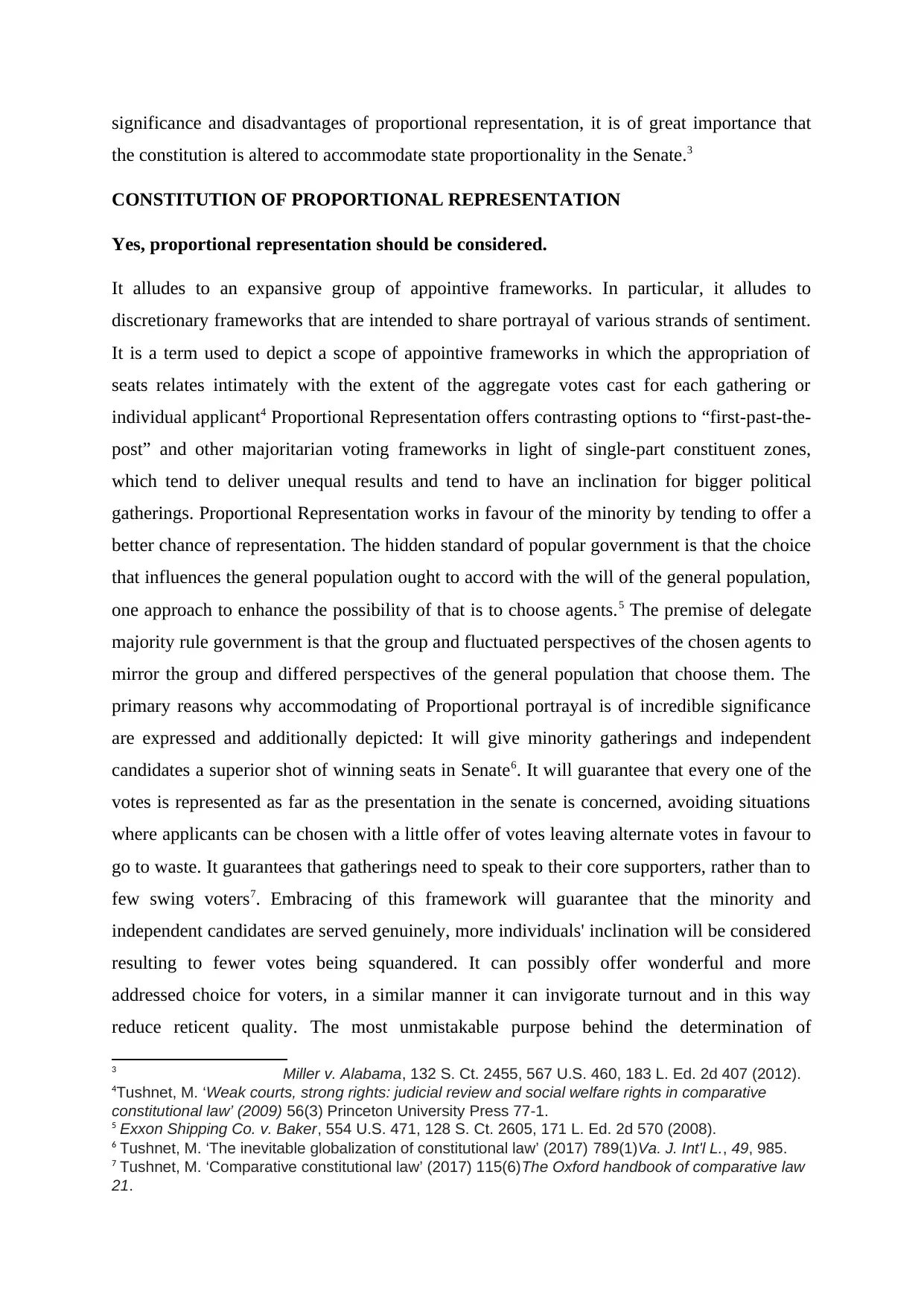
significance and disadvantages of proportional representation, it is of great importance that
the constitution is altered to accommodate state proportionality in the Senate.3
CONSTITUTION OF PROPORTIONAL REPRESENTATION
Yes, proportional representation should be considered.
It alludes to an expansive group of appointive frameworks. In particular, it alludes to
discretionary frameworks that are intended to share portrayal of various strands of sentiment.
It is a term used to depict a scope of appointive frameworks in which the appropriation of
seats relates intimately with the extent of the aggregate votes cast for each gathering or
individual applicant4 Proportional Representation offers contrasting options to “first-past-the-
post” and other majoritarian voting frameworks in light of single-part constituent zones,
which tend to deliver unequal results and tend to have an inclination for bigger political
gatherings. Proportional Representation works in favour of the minority by tending to offer a
better chance of representation. The hidden standard of popular government is that the choice
that influences the general population ought to accord with the will of the general population,
one approach to enhance the possibility of that is to choose agents.5 The premise of delegate
majority rule government is that the group and fluctuated perspectives of the chosen agents to
mirror the group and differed perspectives of the general population that choose them. The
primary reasons why accommodating of Proportional portrayal is of incredible significance
are expressed and additionally depicted: It will give minority gatherings and independent
candidates a superior shot of winning seats in Senate6. It will guarantee that every one of the
votes is represented as far as the presentation in the senate is concerned, avoiding situations
where applicants can be chosen with a little offer of votes leaving alternate votes in favour to
go to waste. It guarantees that gatherings need to speak to their core supporters, rather than to
few swing voters7. Embracing of this framework will guarantee that the minority and
independent candidates are served genuinely, more individuals' inclination will be considered
resulting to fewer votes being squandered. It can possibly offer wonderful and more
addressed choice for voters, in a similar manner it can invigorate turnout and in this way
reduce reticent quality. The most unmistakable purpose behind the determination of
3 Miller v. Alabama, 132 S. Ct. 2455, 567 U.S. 460, 183 L. Ed. 2d 407 (2012).
4Tushnet, M. ‘Weak courts, strong rights: judicial review and social welfare rights in comparative
constitutional law’ (2009) 56(3) Princeton University Press 77-1.
5 Exxon Shipping Co. v. Baker, 554 U.S. 471, 128 S. Ct. 2605, 171 L. Ed. 2d 570 (2008).
6 Tushnet, M. ‘The inevitable globalization of constitutional law’ (2017) 789(1)Va. J. Int'l L., 49, 985.
7 Tushnet, M. ‘Comparative constitutional law’ (2017) 115(6)The Oxford handbook of comparative law
21.
the constitution is altered to accommodate state proportionality in the Senate.3
CONSTITUTION OF PROPORTIONAL REPRESENTATION
Yes, proportional representation should be considered.
It alludes to an expansive group of appointive frameworks. In particular, it alludes to
discretionary frameworks that are intended to share portrayal of various strands of sentiment.
It is a term used to depict a scope of appointive frameworks in which the appropriation of
seats relates intimately with the extent of the aggregate votes cast for each gathering or
individual applicant4 Proportional Representation offers contrasting options to “first-past-the-
post” and other majoritarian voting frameworks in light of single-part constituent zones,
which tend to deliver unequal results and tend to have an inclination for bigger political
gatherings. Proportional Representation works in favour of the minority by tending to offer a
better chance of representation. The hidden standard of popular government is that the choice
that influences the general population ought to accord with the will of the general population,
one approach to enhance the possibility of that is to choose agents.5 The premise of delegate
majority rule government is that the group and fluctuated perspectives of the chosen agents to
mirror the group and differed perspectives of the general population that choose them. The
primary reasons why accommodating of Proportional portrayal is of incredible significance
are expressed and additionally depicted: It will give minority gatherings and independent
candidates a superior shot of winning seats in Senate6. It will guarantee that every one of the
votes is represented as far as the presentation in the senate is concerned, avoiding situations
where applicants can be chosen with a little offer of votes leaving alternate votes in favour to
go to waste. It guarantees that gatherings need to speak to their core supporters, rather than to
few swing voters7. Embracing of this framework will guarantee that the minority and
independent candidates are served genuinely, more individuals' inclination will be considered
resulting to fewer votes being squandered. It can possibly offer wonderful and more
addressed choice for voters, in a similar manner it can invigorate turnout and in this way
reduce reticent quality. The most unmistakable purpose behind the determination of
3 Miller v. Alabama, 132 S. Ct. 2455, 567 U.S. 460, 183 L. Ed. 2d 407 (2012).
4Tushnet, M. ‘Weak courts, strong rights: judicial review and social welfare rights in comparative
constitutional law’ (2009) 56(3) Princeton University Press 77-1.
5 Exxon Shipping Co. v. Baker, 554 U.S. 471, 128 S. Ct. 2605, 171 L. Ed. 2d 570 (2008).
6 Tushnet, M. ‘The inevitable globalization of constitutional law’ (2017) 789(1)Va. J. Int'l L., 49, 985.
7 Tushnet, M. ‘Comparative constitutional law’ (2017) 115(6)The Oxford handbook of comparative law
21.
⊘ This is a preview!⊘
Do you want full access?
Subscribe today to unlock all pages.

Trusted by 1+ million students worldwide
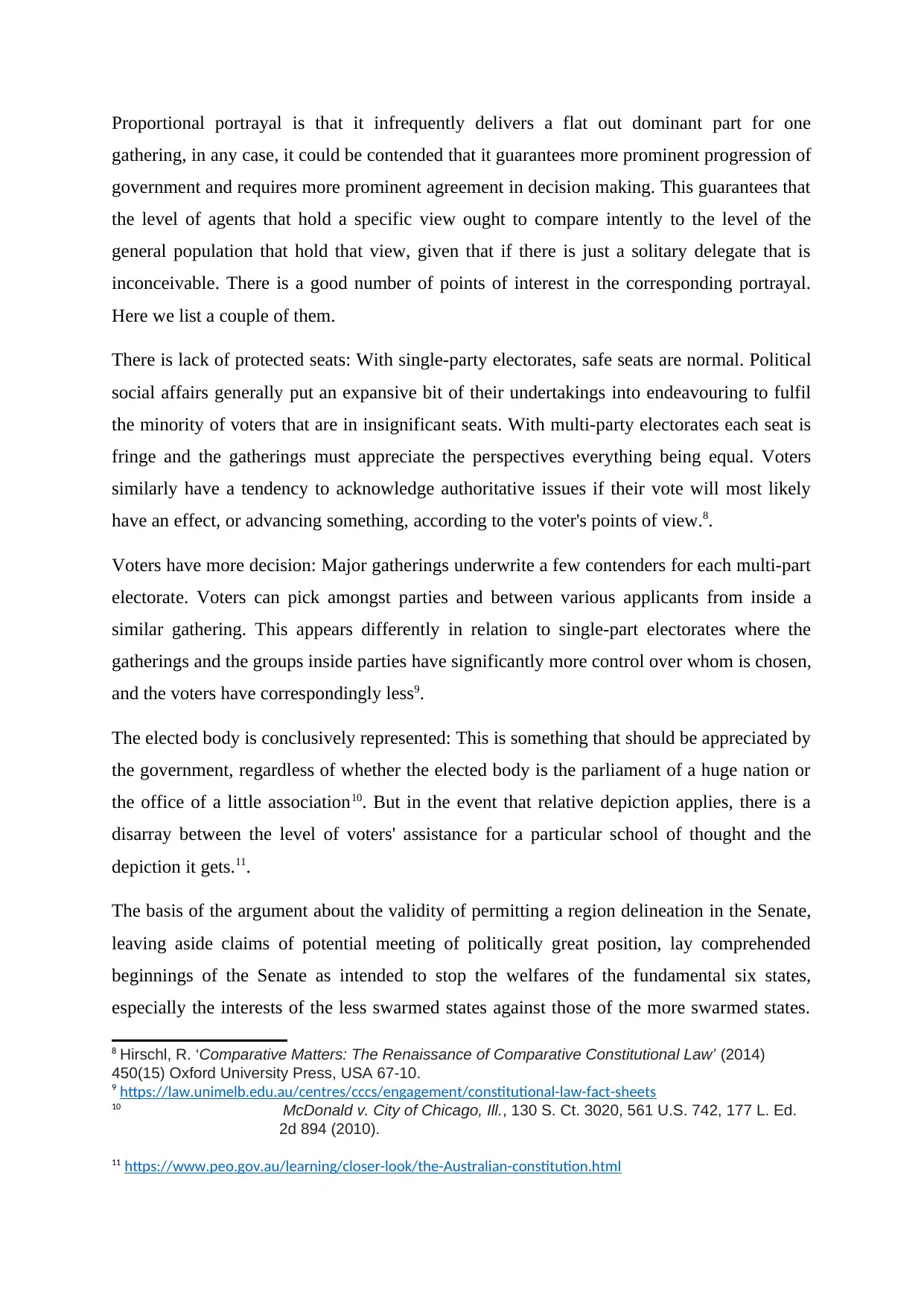
Proportional portrayal is that it infrequently delivers a flat out dominant part for one
gathering, in any case, it could be contended that it guarantees more prominent progression of
government and requires more prominent agreement in decision making. This guarantees that
the level of agents that hold a specific view ought to compare intently to the level of the
general population that hold that view, given that if there is just a solitary delegate that is
inconceivable. There is a good number of points of interest in the corresponding portrayal.
Here we list a couple of them.
There is lack of protected seats: With single-party electorates, safe seats are normal. Political
social affairs generally put an expansive bit of their undertakings into endeavouring to fulfil
the minority of voters that are in insignificant seats. With multi-party electorates each seat is
fringe and the gatherings must appreciate the perspectives everything being equal. Voters
similarly have a tendency to acknowledge authoritative issues if their vote will most likely
have an effect, or advancing something, according to the voter's points of view.8.
Voters have more decision: Major gatherings underwrite a few contenders for each multi-part
electorate. Voters can pick amongst parties and between various applicants from inside a
similar gathering. This appears differently in relation to single-part electorates where the
gatherings and the groups inside parties have significantly more control over whom is chosen,
and the voters have correspondingly less9.
The elected body is conclusively represented: This is something that should be appreciated by
the government, regardless of whether the elected body is the parliament of a huge nation or
the office of a little association10. But in the event that relative depiction applies, there is a
disarray between the level of voters' assistance for a particular school of thought and the
depiction it gets.11.
The basis of the argument about the validity of permitting a region delineation in the Senate,
leaving aside claims of potential meeting of politically great position, lay comprehended
beginnings of the Senate as intended to stop the welfares of the fundamental six states,
especially the interests of the less swarmed states against those of the more swarmed states.
8 Hirschl, R. ‘Comparative Matters: The Renaissance of Comparative Constitutional Law’ (2014)
450(15) Oxford University Press, USA 67-10.
9 https://law.unimelb.edu.au/centres/cccs/engagement/constitutional-law-fact-sheets
10 McDonald v. City of Chicago, Ill., 130 S. Ct. 3020, 561 U.S. 742, 177 L. Ed.
2d 894 (2010).
11 https://www.peo.gov.au/learning/closer-look/the-Australian-constitution.html
gathering, in any case, it could be contended that it guarantees more prominent progression of
government and requires more prominent agreement in decision making. This guarantees that
the level of agents that hold a specific view ought to compare intently to the level of the
general population that hold that view, given that if there is just a solitary delegate that is
inconceivable. There is a good number of points of interest in the corresponding portrayal.
Here we list a couple of them.
There is lack of protected seats: With single-party electorates, safe seats are normal. Political
social affairs generally put an expansive bit of their undertakings into endeavouring to fulfil
the minority of voters that are in insignificant seats. With multi-party electorates each seat is
fringe and the gatherings must appreciate the perspectives everything being equal. Voters
similarly have a tendency to acknowledge authoritative issues if their vote will most likely
have an effect, or advancing something, according to the voter's points of view.8.
Voters have more decision: Major gatherings underwrite a few contenders for each multi-part
electorate. Voters can pick amongst parties and between various applicants from inside a
similar gathering. This appears differently in relation to single-part electorates where the
gatherings and the groups inside parties have significantly more control over whom is chosen,
and the voters have correspondingly less9.
The elected body is conclusively represented: This is something that should be appreciated by
the government, regardless of whether the elected body is the parliament of a huge nation or
the office of a little association10. But in the event that relative depiction applies, there is a
disarray between the level of voters' assistance for a particular school of thought and the
depiction it gets.11.
The basis of the argument about the validity of permitting a region delineation in the Senate,
leaving aside claims of potential meeting of politically great position, lay comprehended
beginnings of the Senate as intended to stop the welfares of the fundamental six states,
especially the interests of the less swarmed states against those of the more swarmed states.
8 Hirschl, R. ‘Comparative Matters: The Renaissance of Comparative Constitutional Law’ (2014)
450(15) Oxford University Press, USA 67-10.
9 https://law.unimelb.edu.au/centres/cccs/engagement/constitutional-law-fact-sheets
10 McDonald v. City of Chicago, Ill., 130 S. Ct. 3020, 561 U.S. 742, 177 L. Ed.
2d 894 (2010).
11 https://www.peo.gov.au/learning/closer-look/the-Australian-constitution.html
Paraphrase This Document
Need a fresh take? Get an instant paraphrase of this document with our AI Paraphraser
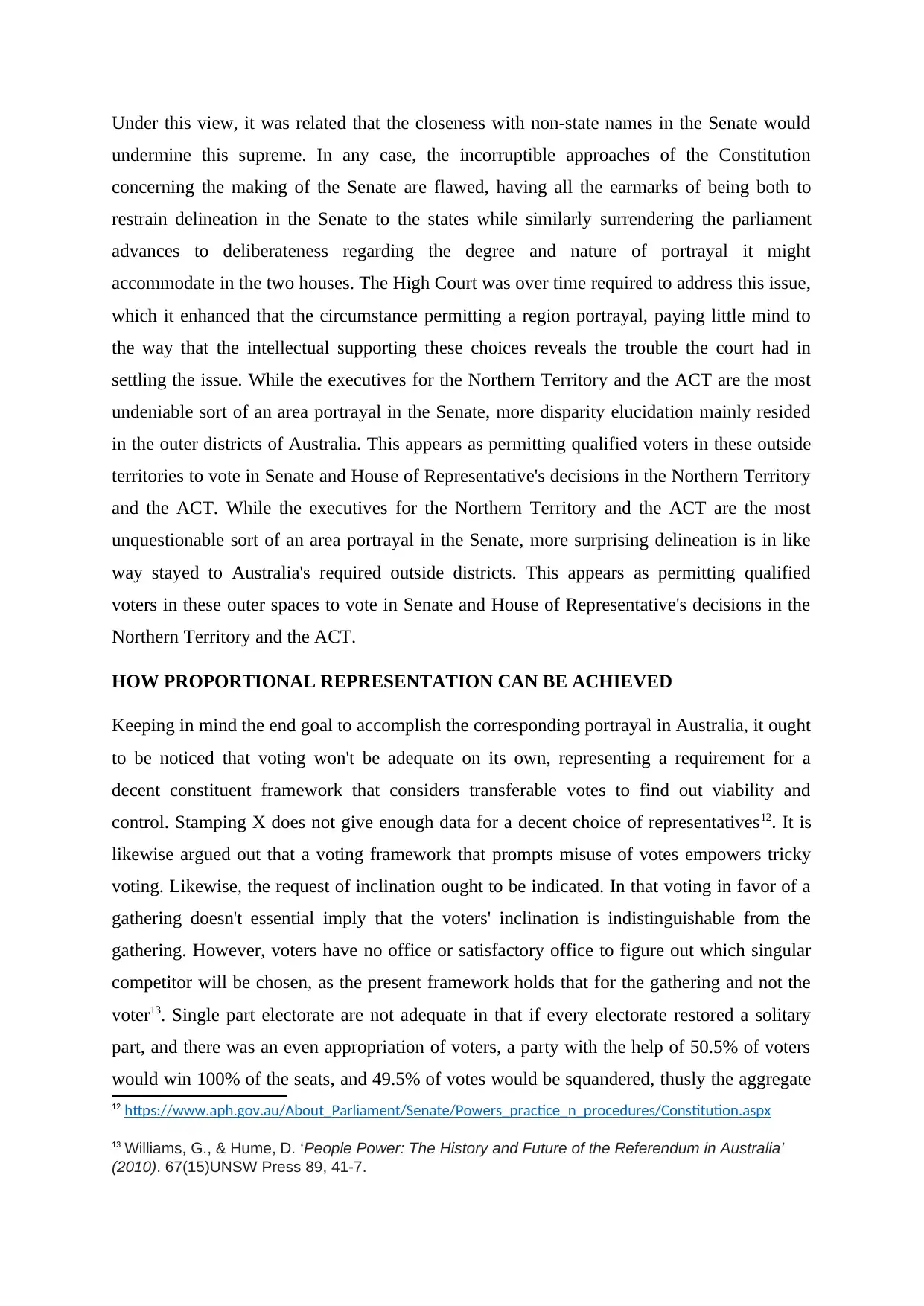
Under this view, it was related that the closeness with non-state names in the Senate would
undermine this supreme. In any case, the incorruptible approaches of the Constitution
concerning the making of the Senate are flawed, having all the earmarks of being both to
restrain delineation in the Senate to the states while similarly surrendering the parliament
advances to deliberateness regarding the degree and nature of portrayal it might
accommodate in the two houses. The High Court was over time required to address this issue,
which it enhanced that the circumstance permitting a region portrayal, paying little mind to
the way that the intellectual supporting these choices reveals the trouble the court had in
settling the issue. While the executives for the Northern Territory and the ACT are the most
undeniable sort of an area portrayal in the Senate, more disparity elucidation mainly resided
in the outer districts of Australia. This appears as permitting qualified voters in these outside
territories to vote in Senate and House of Representative's decisions in the Northern Territory
and the ACT. While the executives for the Northern Territory and the ACT are the most
unquestionable sort of an area portrayal in the Senate, more surprising delineation is in like
way stayed to Australia's required outside districts. This appears as permitting qualified
voters in these outer spaces to vote in Senate and House of Representative's decisions in the
Northern Territory and the ACT.
HOW PROPORTIONAL REPRESENTATION CAN BE ACHIEVED
Keeping in mind the end goal to accomplish the corresponding portrayal in Australia, it ought
to be noticed that voting won't be adequate on its own, representing a requirement for a
decent constituent framework that considers transferable votes to find out viability and
control. Stamping X does not give enough data for a decent choice of representatives12. It is
likewise argued out that a voting framework that prompts misuse of votes empowers tricky
voting. Likewise, the request of inclination ought to be indicated. In that voting in favor of a
gathering doesn't essential imply that the voters' inclination is indistinguishable from the
gathering. However, voters have no office or satisfactory office to figure out which singular
competitor will be chosen, as the present framework holds that for the gathering and not the
voter13. Single part electorate are not adequate in that if every electorate restored a solitary
part, and there was an even appropriation of voters, a party with the help of 50.5% of voters
would win 100% of the seats, and 49.5% of votes would be squandered, thusly the aggregate
12 https://www.aph.gov.au/About_Parliament/Senate/Powers_practice_n_procedures/Constitution.aspx
13 Williams, G., & Hume, D. ‘People Power: The History and Future of the Referendum in Australia’
(2010). 67(15)UNSW Press 89, 41-7.
undermine this supreme. In any case, the incorruptible approaches of the Constitution
concerning the making of the Senate are flawed, having all the earmarks of being both to
restrain delineation in the Senate to the states while similarly surrendering the parliament
advances to deliberateness regarding the degree and nature of portrayal it might
accommodate in the two houses. The High Court was over time required to address this issue,
which it enhanced that the circumstance permitting a region portrayal, paying little mind to
the way that the intellectual supporting these choices reveals the trouble the court had in
settling the issue. While the executives for the Northern Territory and the ACT are the most
undeniable sort of an area portrayal in the Senate, more disparity elucidation mainly resided
in the outer districts of Australia. This appears as permitting qualified voters in these outside
territories to vote in Senate and House of Representative's decisions in the Northern Territory
and the ACT. While the executives for the Northern Territory and the ACT are the most
unquestionable sort of an area portrayal in the Senate, more surprising delineation is in like
way stayed to Australia's required outside districts. This appears as permitting qualified
voters in these outer spaces to vote in Senate and House of Representative's decisions in the
Northern Territory and the ACT.
HOW PROPORTIONAL REPRESENTATION CAN BE ACHIEVED
Keeping in mind the end goal to accomplish the corresponding portrayal in Australia, it ought
to be noticed that voting won't be adequate on its own, representing a requirement for a
decent constituent framework that considers transferable votes to find out viability and
control. Stamping X does not give enough data for a decent choice of representatives12. It is
likewise argued out that a voting framework that prompts misuse of votes empowers tricky
voting. Likewise, the request of inclination ought to be indicated. In that voting in favor of a
gathering doesn't essential imply that the voters' inclination is indistinguishable from the
gathering. However, voters have no office or satisfactory office to figure out which singular
competitor will be chosen, as the present framework holds that for the gathering and not the
voter13. Single part electorate are not adequate in that if every electorate restored a solitary
part, and there was an even appropriation of voters, a party with the help of 50.5% of voters
would win 100% of the seats, and 49.5% of votes would be squandered, thusly the aggregate
12 https://www.aph.gov.au/About_Parliament/Senate/Powers_practice_n_procedures/Constitution.aspx
13 Williams, G., & Hume, D. ‘People Power: The History and Future of the Referendum in Australia’
(2010). 67(15)UNSW Press 89, 41-7.
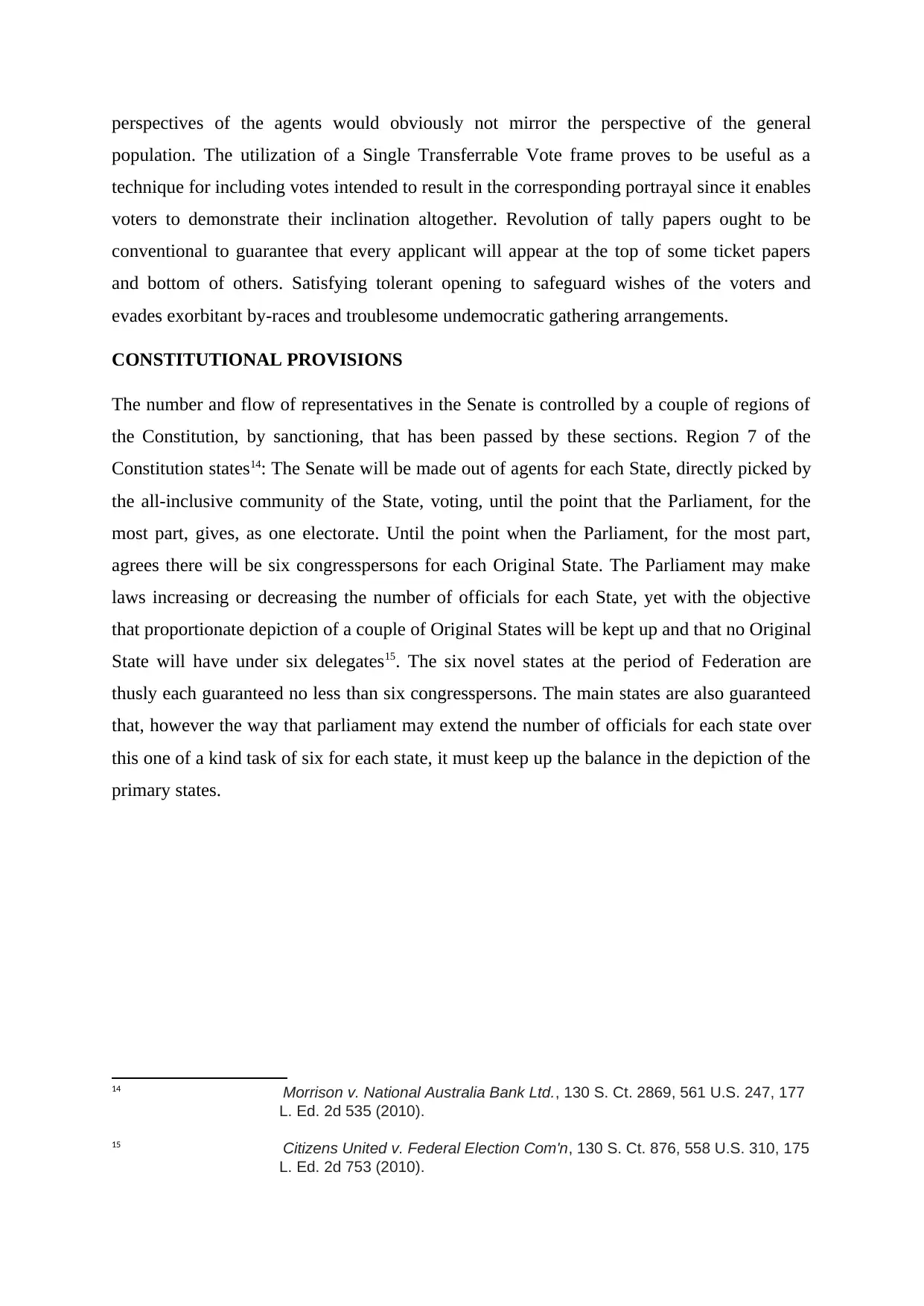
perspectives of the agents would obviously not mirror the perspective of the general
population. The utilization of a Single Transferrable Vote frame proves to be useful as a
technique for including votes intended to result in the corresponding portrayal since it enables
voters to demonstrate their inclination altogether. Revolution of tally papers ought to be
conventional to guarantee that every applicant will appear at the top of some ticket papers
and bottom of others. Satisfying tolerant opening to safeguard wishes of the voters and
evades exorbitant by-races and troublesome undemocratic gathering arrangements.
CONSTITUTIONAL PROVISIONS
The number and flow of representatives in the Senate is controlled by a couple of regions of
the Constitution, by sanctioning, that has been passed by these sections. Region 7 of the
Constitution states14: The Senate will be made out of agents for each State, directly picked by
the all-inclusive community of the State, voting, until the point that the Parliament, for the
most part, gives, as one electorate. Until the point when the Parliament, for the most part,
agrees there will be six congresspersons for each Original State. The Parliament may make
laws increasing or decreasing the number of officials for each State, yet with the objective
that proportionate depiction of a couple of Original States will be kept up and that no Original
State will have under six delegates15. The six novel states at the period of Federation are
thusly each guaranteed no less than six congresspersons. The main states are also guaranteed
that, however the way that parliament may extend the number of officials for each state over
this one of a kind task of six for each state, it must keep up the balance in the depiction of the
primary states.
14 Morrison v. National Australia Bank Ltd., 130 S. Ct. 2869, 561 U.S. 247, 177
L. Ed. 2d 535 (2010).
15 Citizens United v. Federal Election Com'n, 130 S. Ct. 876, 558 U.S. 310, 175
L. Ed. 2d 753 (2010).
population. The utilization of a Single Transferrable Vote frame proves to be useful as a
technique for including votes intended to result in the corresponding portrayal since it enables
voters to demonstrate their inclination altogether. Revolution of tally papers ought to be
conventional to guarantee that every applicant will appear at the top of some ticket papers
and bottom of others. Satisfying tolerant opening to safeguard wishes of the voters and
evades exorbitant by-races and troublesome undemocratic gathering arrangements.
CONSTITUTIONAL PROVISIONS
The number and flow of representatives in the Senate is controlled by a couple of regions of
the Constitution, by sanctioning, that has been passed by these sections. Region 7 of the
Constitution states14: The Senate will be made out of agents for each State, directly picked by
the all-inclusive community of the State, voting, until the point that the Parliament, for the
most part, gives, as one electorate. Until the point when the Parliament, for the most part,
agrees there will be six congresspersons for each Original State. The Parliament may make
laws increasing or decreasing the number of officials for each State, yet with the objective
that proportionate depiction of a couple of Original States will be kept up and that no Original
State will have under six delegates15. The six novel states at the period of Federation are
thusly each guaranteed no less than six congresspersons. The main states are also guaranteed
that, however the way that parliament may extend the number of officials for each state over
this one of a kind task of six for each state, it must keep up the balance in the depiction of the
primary states.
14 Morrison v. National Australia Bank Ltd., 130 S. Ct. 2869, 561 U.S. 247, 177
L. Ed. 2d 535 (2010).
15 Citizens United v. Federal Election Com'n, 130 S. Ct. 876, 558 U.S. 310, 175
L. Ed. 2d 753 (2010).
⊘ This is a preview!⊘
Do you want full access?
Subscribe today to unlock all pages.

Trusted by 1+ million students worldwide
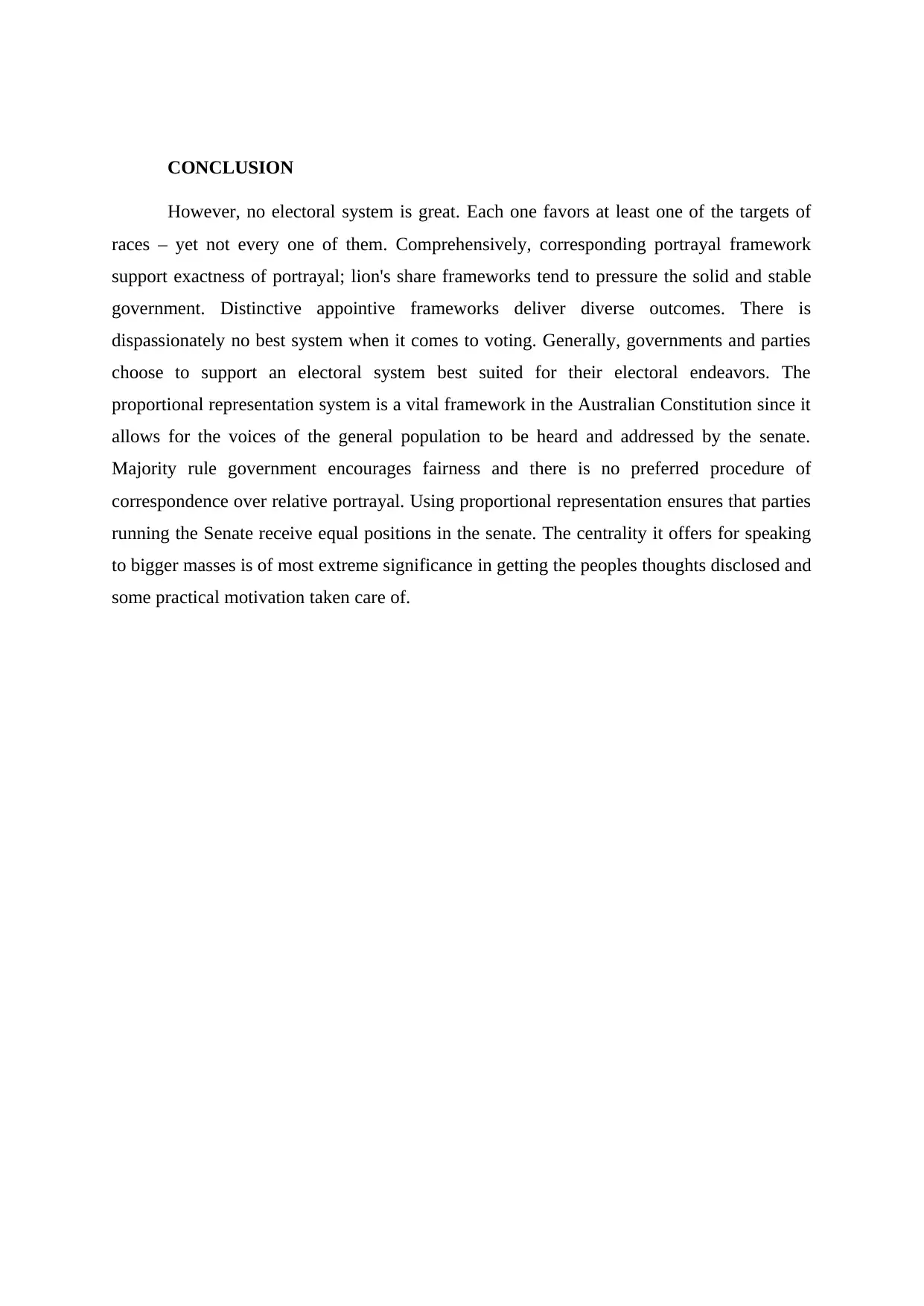
CONCLUSION
However, no electoral system is great. Each one favors at least one of the targets of
races – yet not every one of them. Comprehensively, corresponding portrayal framework
support exactness of portrayal; lion's share frameworks tend to pressure the solid and stable
government. Distinctive appointive frameworks deliver diverse outcomes. There is
dispassionately no best system when it comes to voting. Generally, governments and parties
choose to support an electoral system best suited for their electoral endeavors. The
proportional representation system is a vital framework in the Australian Constitution since it
allows for the voices of the general population to be heard and addressed by the senate.
Majority rule government encourages fairness and there is no preferred procedure of
correspondence over relative portrayal. Using proportional representation ensures that parties
running the Senate receive equal positions in the senate. The centrality it offers for speaking
to bigger masses is of most extreme significance in getting the peoples thoughts disclosed and
some practical motivation taken care of.
However, no electoral system is great. Each one favors at least one of the targets of
races – yet not every one of them. Comprehensively, corresponding portrayal framework
support exactness of portrayal; lion's share frameworks tend to pressure the solid and stable
government. Distinctive appointive frameworks deliver diverse outcomes. There is
dispassionately no best system when it comes to voting. Generally, governments and parties
choose to support an electoral system best suited for their electoral endeavors. The
proportional representation system is a vital framework in the Australian Constitution since it
allows for the voices of the general population to be heard and addressed by the senate.
Majority rule government encourages fairness and there is no preferred procedure of
correspondence over relative portrayal. Using proportional representation ensures that parties
running the Senate receive equal positions in the senate. The centrality it offers for speaking
to bigger masses is of most extreme significance in getting the peoples thoughts disclosed and
some practical motivation taken care of.
Paraphrase This Document
Need a fresh take? Get an instant paraphrase of this document with our AI Paraphraser
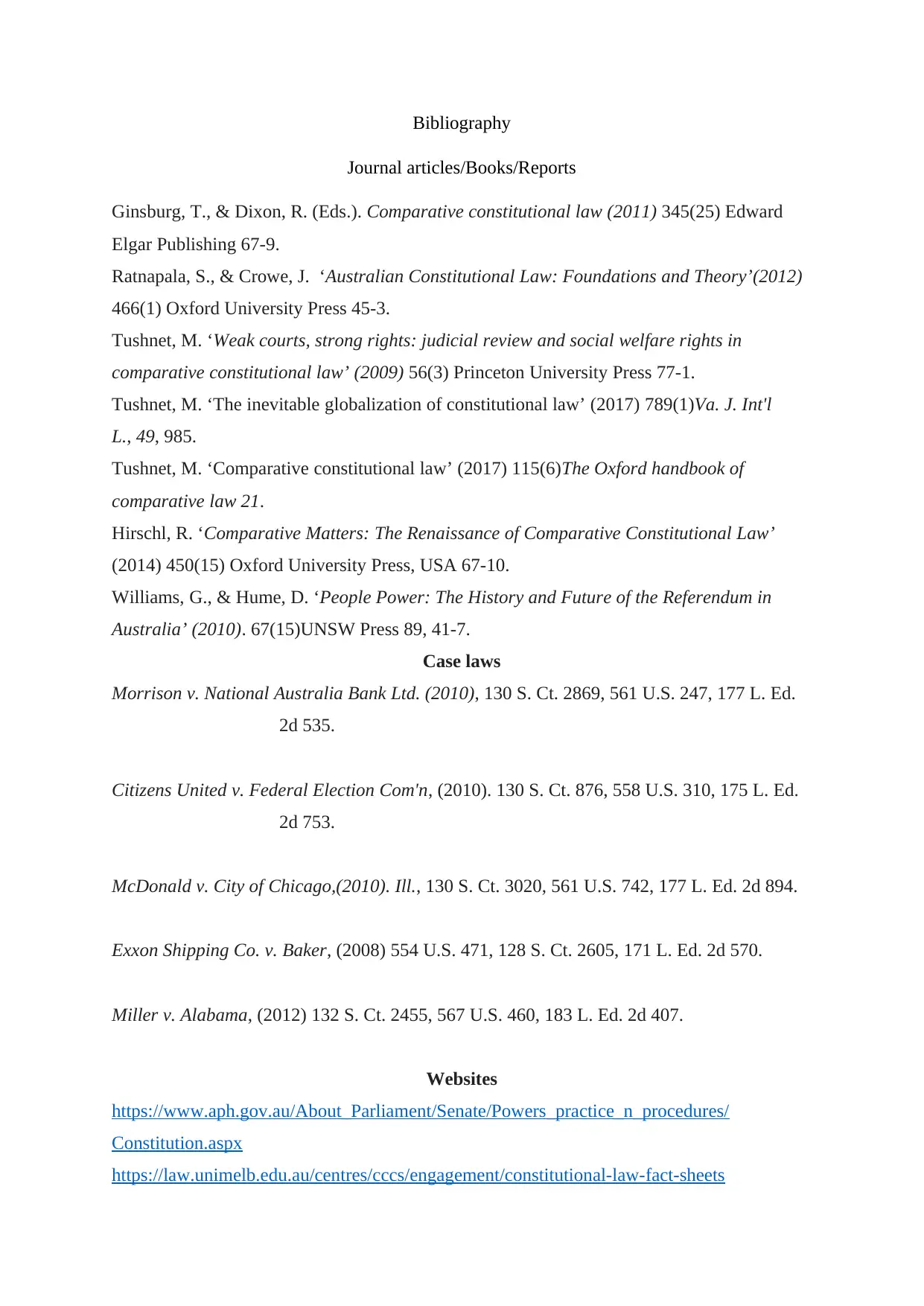
Bibliography
Journal articles/Books/Reports
Ginsburg, T., & Dixon, R. (Eds.). Comparative constitutional law (2011) 345(25) Edward
Elgar Publishing 67-9.
Ratnapala, S., & Crowe, J. ‘Australian Constitutional Law: Foundations and Theory’(2012)
466(1) Oxford University Press 45-3.
Tushnet, M. ‘Weak courts, strong rights: judicial review and social welfare rights in
comparative constitutional law’ (2009) 56(3) Princeton University Press 77-1.
Tushnet, M. ‘The inevitable globalization of constitutional law’ (2017) 789(1)Va. J. Int'l
L., 49, 985.
Tushnet, M. ‘Comparative constitutional law’ (2017) 115(6)The Oxford handbook of
comparative law 21.
Hirschl, R. ‘Comparative Matters: The Renaissance of Comparative Constitutional Law’
(2014) 450(15) Oxford University Press, USA 67-10.
Williams, G., & Hume, D. ‘People Power: The History and Future of the Referendum in
Australia’ (2010). 67(15)UNSW Press 89, 41-7.
Case laws
Morrison v. National Australia Bank Ltd. (2010), 130 S. Ct. 2869, 561 U.S. 247, 177 L. Ed.
2d 535.
Citizens United v. Federal Election Com'n, (2010). 130 S. Ct. 876, 558 U.S. 310, 175 L. Ed.
2d 753.
McDonald v. City of Chicago,(2010). Ill., 130 S. Ct. 3020, 561 U.S. 742, 177 L. Ed. 2d 894.
Exxon Shipping Co. v. Baker, (2008) 554 U.S. 471, 128 S. Ct. 2605, 171 L. Ed. 2d 570.
Miller v. Alabama, (2012) 132 S. Ct. 2455, 567 U.S. 460, 183 L. Ed. 2d 407.
Websites
https://www.aph.gov.au/About_Parliament/Senate/Powers_practice_n_procedures/
Constitution.aspx
https://law.unimelb.edu.au/centres/cccs/engagement/constitutional-law-fact-sheets
Journal articles/Books/Reports
Ginsburg, T., & Dixon, R. (Eds.). Comparative constitutional law (2011) 345(25) Edward
Elgar Publishing 67-9.
Ratnapala, S., & Crowe, J. ‘Australian Constitutional Law: Foundations and Theory’(2012)
466(1) Oxford University Press 45-3.
Tushnet, M. ‘Weak courts, strong rights: judicial review and social welfare rights in
comparative constitutional law’ (2009) 56(3) Princeton University Press 77-1.
Tushnet, M. ‘The inevitable globalization of constitutional law’ (2017) 789(1)Va. J. Int'l
L., 49, 985.
Tushnet, M. ‘Comparative constitutional law’ (2017) 115(6)The Oxford handbook of
comparative law 21.
Hirschl, R. ‘Comparative Matters: The Renaissance of Comparative Constitutional Law’
(2014) 450(15) Oxford University Press, USA 67-10.
Williams, G., & Hume, D. ‘People Power: The History and Future of the Referendum in
Australia’ (2010). 67(15)UNSW Press 89, 41-7.
Case laws
Morrison v. National Australia Bank Ltd. (2010), 130 S. Ct. 2869, 561 U.S. 247, 177 L. Ed.
2d 535.
Citizens United v. Federal Election Com'n, (2010). 130 S. Ct. 876, 558 U.S. 310, 175 L. Ed.
2d 753.
McDonald v. City of Chicago,(2010). Ill., 130 S. Ct. 3020, 561 U.S. 742, 177 L. Ed. 2d 894.
Exxon Shipping Co. v. Baker, (2008) 554 U.S. 471, 128 S. Ct. 2605, 171 L. Ed. 2d 570.
Miller v. Alabama, (2012) 132 S. Ct. 2455, 567 U.S. 460, 183 L. Ed. 2d 407.
Websites
https://www.aph.gov.au/About_Parliament/Senate/Powers_practice_n_procedures/
Constitution.aspx
https://law.unimelb.edu.au/centres/cccs/engagement/constitutional-law-fact-sheets

https://www.peo.gov.au/learning/closer-look/the-australian-constitution.html
⊘ This is a preview!⊘
Do you want full access?
Subscribe today to unlock all pages.

Trusted by 1+ million students worldwide
1 out of 9
Related Documents
Your All-in-One AI-Powered Toolkit for Academic Success.
+13062052269
info@desklib.com
Available 24*7 on WhatsApp / Email
![[object Object]](/_next/static/media/star-bottom.7253800d.svg)
Unlock your academic potential
Copyright © 2020–2025 A2Z Services. All Rights Reserved. Developed and managed by ZUCOL.




